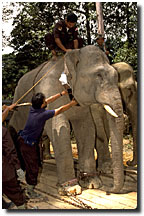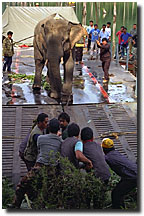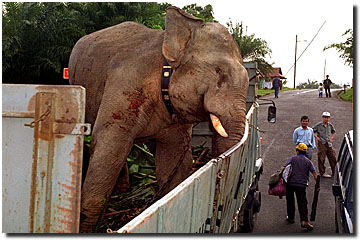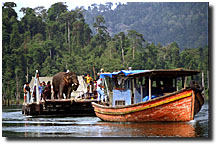
|
|
|
Abang is fitted with a radio-transmitter collar that allows wildlife rangers and scientists to track his movements. (Photograph by David S. T. Loh)
|
|

|
|
|
The expert Malaysian elephant-handling team drags Abang from a barge to Taman Negara National Park after an arduous 20-hour journey. (Photograph by David S. T. Loh)
|
|
|
 ow far will a hungry elephant go for a midnight snack? If he's in Malaysia, not far enough to avoid capture. Wildlife rangers, with the help of scientists from the Smithsonian Institution in Washington, D.C., are tracking the movements of certain crop-marauding pachyderms using radio transmitters and satellites. And now anyone can join this elephant hunt, thanks to the World Wide Web. Using data transmitted eight times a day from a radio beacon attached to the animal, computers plot the elephant's travels, which are then charted and posted on the Net.
ow far will a hungry elephant go for a midnight snack? If he's in Malaysia, not far enough to avoid capture. Wildlife rangers, with the help of scientists from the Smithsonian Institution in Washington, D.C., are tracking the movements of certain crop-marauding pachyderms using radio transmitters and satellites. And now anyone can join this elephant hunt, thanks to the World Wide Web. Using data transmitted eight times a day from a radio beacon attached to the animal, computers plot the elephant's travels, which are then charted and posted on the Net. On February 8, 1996, the Malaysian rangers caught a rogue bull named Abang Ramadan ("Brother Ramadan"), who became the second trespasser to be collared with a radio transmitter. The three-and-a-half-ton animal had been feeding in the old forest by day but stepping out at night to the banana plantations for dessert. Photographer David Loh accompanied the rangers as they captured and transported the voracious creature from the tempting banana fields to a more remote area upriver. As more land is cleared for agriculture, the predicament of displaced animals such as Abang Ramadan is no longer uncommon. Most elephants withdraw peacefully, but some continue to push through electric fences and other barriers in search of forbidden fruit, causing severe crop damage in the process. The Department of Wildlife and National Parks employs these elephant bouncers and spends thousands of dollars and hundreds of back-breaking hours ensuring that the beasts are not harmed. Everyone benefits from the high-tech, low-jungle joint venture: The farmers protect their crops; the scientists gather from the Internet instantaneous data about wild elephants; and the pachyderms dine in peace.
|









 ow far will a hungry elephant go for a midnight snack? If he's in Malaysia, not far enough to avoid capture. Wildlife rangers, with the help of scientists from the Smithsonian Institution in Washington, D.C., are tracking the movements of certain crop-marauding pachyderms using radio transmitters and satellites. And now anyone can join this elephant hunt, thanks to the World Wide Web. Using data transmitted eight times a day from a radio beacon attached to the animal, computers plot the elephant's travels, which are then charted and posted on the Net.
ow far will a hungry elephant go for a midnight snack? If he's in Malaysia, not far enough to avoid capture. Wildlife rangers, with the help of scientists from the Smithsonian Institution in Washington, D.C., are tracking the movements of certain crop-marauding pachyderms using radio transmitters and satellites. And now anyone can join this elephant hunt, thanks to the World Wide Web. Using data transmitted eight times a day from a radio beacon attached to the animal, computers plot the elephant's travels, which are then charted and posted on the Net. 

